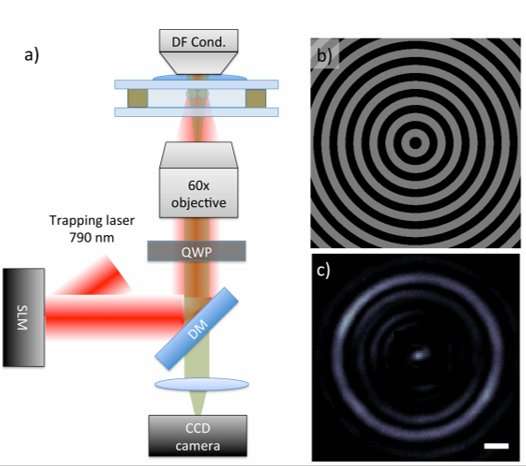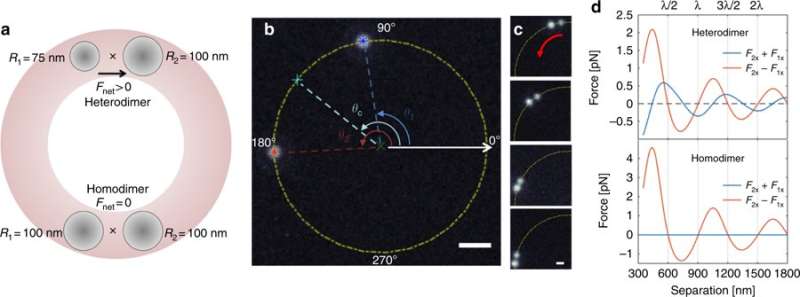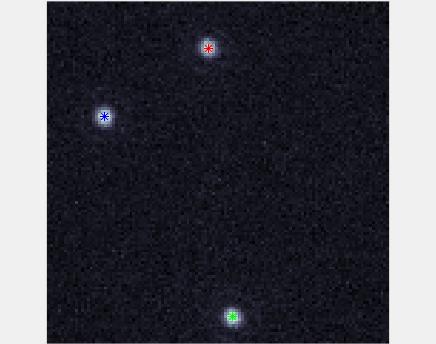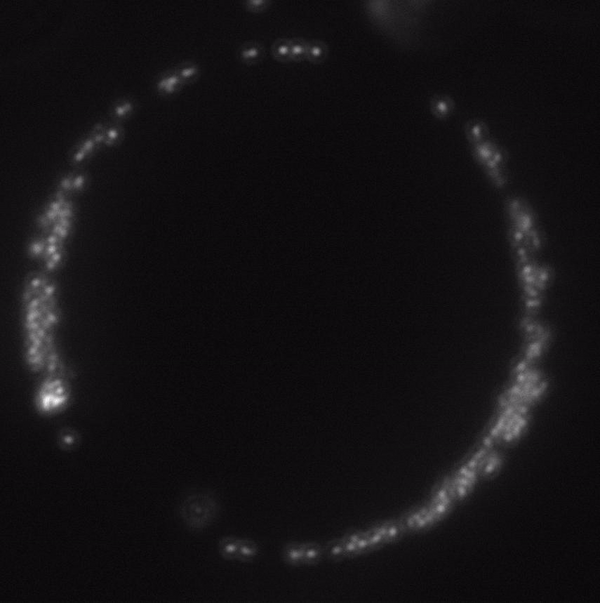December 28, 2018 feature
Reactive optical matter: Light-induced motion

Newton's third law dictates that forces between interacting particles are equal and opposite for closed systems. In a non-equilibrium environment, the third law can be defied, giving rise to "nonreciprocal" forces. Theoretically, this was shown when dissimilar, optically trapped particles were mediated by an external field. In a recent study, Yuval Yifat and colleagues measured the net nonreciprocal forces in electrodynamically interacting, asymmetric nanoparticle dimers and nanoparticle aggregates. In the experiments, the nanoparticle structures were confined to pseudo one-dimensional geometries and illuminated by plane waves. The observed motion was due to the conservation of total momentum for particles and fields with broken mirror symmetry (represented by a changed direction of motion). The results are now published on Light: Science & Applications.
The ability to convert light energy into self-directed motion with light-driven nanomotors or micromachines has already attracted great interest. A variety of methods in optics can produce rotational motion or give rise to translational motion with photoreactive materials. The promise to engineer light-driven nanomotors arose from recent theoretical work, which predicted that dissimilar particles illuminated by an electromagnetic plane wave, will experience a nonreciprocal net force.
The predicted nonreciprocal forces were demonstrated with simulations to vary very little with interparticle separation. However, straightforward experimental evidence on the phenomenon was not presented thus far. Exploring the reactive optical effects can open new possibilities of self-assembling, light-driven micromachines to herald a new field in optics and photonics.
To fill the experimental gap, in the present study, Yifat et al. demonstrated self-motility using optically bound dimers of disproportionate metallic nanoparticles (NPs). The experimental findings were also supported by quantitative electrodynamic simulations. Aside from dimers, the scientists similarly generated and measured the motion of asymmetric nanoparticle clusters or assemblies. To perform the experiments, Yifat et al. used a standard optical trapping setup with a Ti:Sapphire laser operating at a wavelength of 790 nm. A tightly focused, circularly polarized spatially phase-modulated beam of light formed an optical ring trap.

In the study, the motion of a trapped mixture of silver (Ag) nanoparticles with 150 nm – 200 nm diameter were measured using dark-field microscopy at a high frame rate of 290 fps. The particles were tracked, and their precise position used to calculate the angular position (θi) on the ring. The scientists conducted particle imaging and tracking using the mosaic particle tracking toolbox available via Image J software.
Yifat et al. observed a "heterodimer" of dissimilar particles in which the directed motion of electrodynamically interacting pairs were toward the larger particle. Conversely, when two particles of the same size, termed a "homodimer" came into close proximity, directed motion was not observed. The results were in agreement with the forces calculated using the generalized Mie theory (GMT). The scientists did not observe full or free rotation in the experiment – the manifested torque and its effect will be investigated further in future work.

Thereafter, Yifat et al. imaged the representative time trajectories of θc (the central angle of the pair) for the heterodimers and homodimers. In the heterodimers, motion of the pair was directed toward the larger particle and therefore could move clockwise or counterclockwise, around the ring depending on its orientation. The scientists repeated the experiments and combined the results. In the combined data with different heterodimer orientations, positive velocity was defined as the vector from the smaller sample toward the larger particle.
For instance, the heterodimers exhibited a positive mean angular velocity at an optical binding separation of 600 ± 150 nm and a negative mean angular velocity when the separation was larger at 900 ± 150 nm. In contrast, the mean angular velocity for a homodimer was zero for all separations. The change in mean velocity and the motion of the heterodimer pair toward the larger, thermally hotter particle was due to the electromagnetic field and not due to heat-induced self-thermophoresis (i.e. local temperature gradient generated due to laser adsorption by the metal-coated particles).

The findings agreed with previous publications on the asymmetry of light scattered by optically trapped objects. The simulated motion was similarly directed from the small particle to the larger particle. The scientists observed a separation-dependent imbalance of angular scattering (where more light was scattered in one direction than another). The asymmetry in far-field scattering created a force on the dimer, setting it in motion as observed. Similar asymmetric scattering was previously observed for plasmonic nanoantenna. Yifat et al. used the same experimental approach to study gold (Au) nanostar dimers and large asymmetric aggregates of gold nanoparticles.

In this way, the scientists experimentally demonstrated light-driven motion of heterodimers and asymmetric scatterers in optical ring traps to quantify net nonreciprocal forces in one-dimensional plane wave-fields. Although the experiments were confined to a ring trap in this study, the strategy is transferable to any optically trapped matter structure that exhibits electromagnetic asymmetry. The optical trapping used in the study offered solutions to the experimental challenge of generating directed motion at the nanoscale. Nonreciprocal forces in the study created the self-motile particles without the use of chemical environments, chemical fuels or complex structures.
The electrodynamic theory and simulations that were simultaneously conducted in the study also showed that interparticle interactions caused asymmetric scattering in the heterodimers. The work thus fundamentally followed Noether's theorem (the symmetry of the action of a physical system contains a corresponding conservation law). Accordingly, Yuvat et al. rationalize that the observed self-motility and the quantified nonreciprocal forces followed from the conservation of total momentum of particles and fields, for systems with broken symmetry. The scientists envision the use of such light-driven asymmetric nanoparticle assemblies as active colloids with artificial chemotactic systems, and as fully operational "nanoswimmers" for research in soft condensed matter and biophysics.
More information: Yuval Yifat et al. Reactive optical matter: light-induced motility in electrodynamically asymmetric nanoscale scatterers, Light: Science & Applications (2018). DOI: 10.1038/s41377-018-0105-y
Philosophiae naturalis principia mathematica. Londoni, Jussu Societatis Regiae ac typis Josephi Streater, 1687. www.worldcat.org/title/philoso … osephi-streater-1687
A. V. Ivlev et al. Statistical Mechanics where Newton's Third Law is Broken, Physical Review X (2015). DOI: 10.1103/PhysRevX.5.011035
Vítězslav Karásek et al. Dynamics of an optically bound structure made of particles of unequal sizes, Optics Letters (2017). DOI: 10.1364/OL.42.001436
Hongxu Chen et al. Light-Powered Micro/Nanomotors, Micromachines (2018). DOI: 10.3390/mi9020041
Journal information: Light: Science & Applications , Physical Review X , Optics Letters
© 2018 Science X Network



















